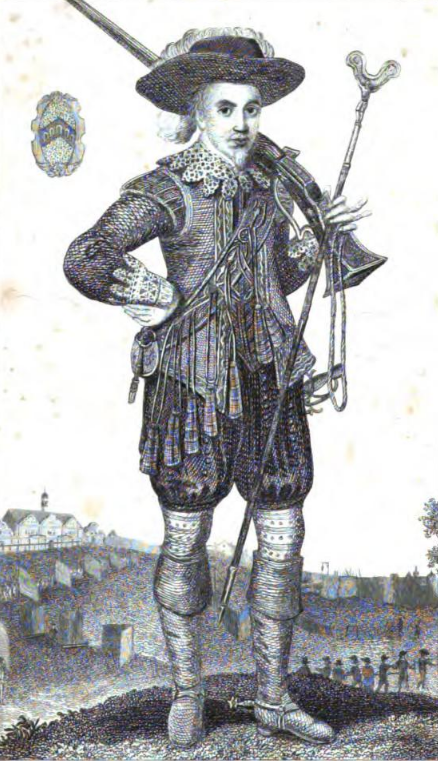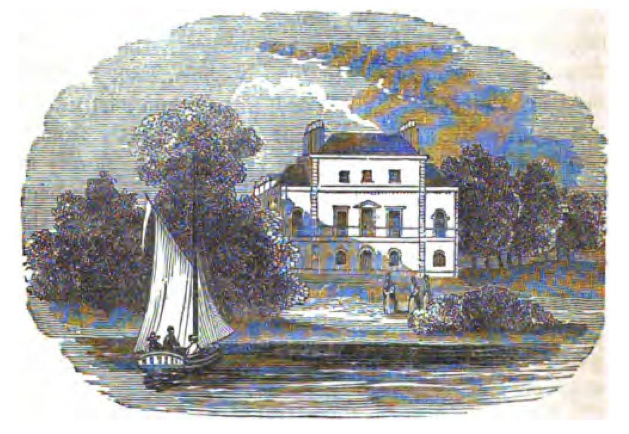Difference between revisions of "MRP: Sir Nicholas Crispe will"
| Line 76: | Line 76: | ||
Leading from the hall was the conservatory, connecting the house with the apratments adjoining the theatre; this suite contained a billiard-room, a coffee-room, and the library, .... The theatre was erected near the waterside, in a castellated form, resembling an ancient ruin... | Leading from the hall was the conservatory, connecting the house with the apratments adjoining the theatre; this suite contained a billiard-room, a coffee-room, and the library, .... The theatre was erected near the waterside, in a castellated form, resembling an ancient ruin... | ||
| − | In the Memoirs published by the Margravine, we find the following description of the premises: "XXX'' | + | In the Memoirs published by the Margravine, we find the following description of the premises: "XXX''[http://www.archive.org/stream/historyandantiq02faulgoog#page/n307/mode/2up Thomas Faulkner, The history and antiquities of the parish of Hammersmith (London, 1839), pp. 283-287] |
| − | + | ---- | |
| − | + | ||
| − | + | ||
| − | + | ||
===Irish adventure, June 1642=== | ===Irish adventure, June 1642=== | ||
Revision as of 15:13, February 27, 2012
Sir Nicholas Crispe will
Editorial history
27/02/12, CSG: Created page
Contents
Abstract & context
Sugested links
To do
Images
Sir Nicholas Crispe, engraving, from a painting, undated
Sir Nicholas Crispe's mansion, Faulkner, circa 1839
Image credits & copyright information
(1) 'Sir Nicholas Crispe, from a painting in the Earl of Leicesters collection,' engraving, undated, anon, reproduced in Thomas Faulkner, The history and antiquities of the parish of Hammersmith (London, 1839), op. title page[1]
(2) 'Brandenburgh house,' ?engraving, ca. 1839, anon, reproduced in Thomas Faulkner, The history and antiquities of the parish of Hammersmith (London, 1839), p. 278[2]
Transcription
Notes
Hammersmith mansion house of Sir Nicholas Crispe
Sir Nicholas Crispe built his mansion house in Hammersmith in XXXX.
Faulkner cites Bowack's Middlesex, which provides a description of the house in 1705:
Upon the Thames, adjoining to Hammersmith, though within the limits of teh Fulham division, is a noble seat, built by Sir Nicholas Crispe, Bart. a gentleman of unshaken loyalty to King Charles I. It stands at a very convenient distance from the Thames, in a sweet and wholesome air, and has a large spot of ground of several acres inclosed, adjoining to it. The building is very lofty, regular, and magnificent, after the modern manner, built with brick, cornered with stone, and has a handsome cuppola at the top. It contains several large handsome rooms, very spacious, and finely finished. The foundations and walls are very substantial, and the vaults underneath arched in an extraordinary manner. The whole house in building, and the gardens, canals, &c. in making, is said to cost near £25,000.
Some time after the death of the said Sir Nicholas Crispe, this house was sold to Mrs. Margaret Hughes,a lady much esteemed at Court about that time, for her air and beauty, in whose possession it had not remained many years, before she disposed of it again, to Timothy Lannoy, Esq. one of her Majesty's Justices of the Peace for this county, and Mr. Treadway, his brother, both Turkey merchants, and gentlemen of known worth, as well abroad as at home. These gentlemen have for many years past lived in this noble seat, and made several other buildings, as dye-houses, &c. for carrying on their business.[3]
Interestingly, Faulkner describes Timothy Lannoy, one of the house's joint occupants from the mid-1690s till 1718, as a "scarlet dyer". Recent archaeological work by the Museum of London (2001-XXXX) discovered probably brick lined dye vats, but the write up of this work dates them to occupation by Sir Nicholas Crispe. It has been suggested that Crispe used the vats to dye cloth, employing dye wood imported by him from West Africa.[4]
Crispe's mansion was modified in post-1740 by Lord Melcombe, first known as George Bubb, Esq., and subsequently known as George Doddington, Esq. Melcombe was the son of an apothecary. He purchased the house in 1740 from Leonora, the only daughter of James Lannoy. The building had been in the tenure of the Duke and Duchess of Athol (Faulkner, 1839: 281). According to Faulkner, Lord Melcombe "repaired and modernized the house, giving it the name of La Trappe, and built a magnificent gallery for statues and antiquities" (Faulkner, 1839: 279)
Three plates of the house as modifed by Lord Melcombe, showing the "elevation towards the Thames, the ground plan, and section of the gallery" (Faulkner, 1839: 283). Faulkner includes an engraving of the house in his own work, showing the house from the river Thames (Faulkner, 1839: 278).
Faulkner provides a detailed description of the house was it was "splendidly fitted up by her Highness, the Margarvine [of Brandenburgh-Ansbergh]", following its acquisition from Lord Melcombe:
The state apartments consisted of five rooms, besides the great gallery, the whole of which were filled with a magnificent collection of paintings, and objects of vertu-
In the small dining-room...
The drawing-room was thirty-eight feet by twenty-three feet...
In the state bed-room...
In the drawing-room was a cabinet, containing a large collection of miniatures, ...a silver oval Medallion of Charles the First and his Queen, dug up a few years since, in the grounds near Brandenburgh-house...
The gallery was eighty feet by twenty, it was originally fitted by Lord Melcombe, and floored with marble...
In the dining-room and dressing-room...two Views of Brandenburgh House, and seat in the gardens, by Wigstead...
In the bed-chamber,...
In the hall, ...
Leading from the hall was the conservatory, connecting the house with the apratments adjoining the theatre; this suite contained a billiard-room, a coffee-room, and the library, .... The theatre was erected near the waterside, in a castellated form, resembling an ancient ruin...
In the Memoirs published by the Margravine, we find the following description of the premises: "XXXThomas Faulkner, The history and antiquities of the parish of Hammersmith (London, 1839), pp. 283-287
Irish adventure, June 1642
"June 1642
[17 June 1642]
Whereas Sir Nicholas Crispe, Knight, Maurice Thompson, Thomas Chamberlaine,[5] Gregory Clement, Richard Waring, John Wood, Richard Shute, George Thompson, William Pennoyer, Thomas Vincent, William Thompson, William Willoughby, Thomas Rainsburrough, Samuell Moyer, and Richard Hill, and their Associates, as well out of their pious and charitable Disposition towards their distressed Brethren His Majesty's Protestant Subjects in the Realm of Ireland, who, being brought into great Misery and Distress, are ready to perish for Want of Relief, as also out of their loyal Respect to His Majesty, and Detestation to that Rebellion, and to reduce the Rebels in the said Realm of Ireland to their due Obedience, and (as much as in them shall lie) to prevent and hinder all such Supplies as shall be sent unto the said Rebels, and likewise, by all possible Ways and Means, to assist and help His Majesty's good Subjects there, and to infest, spoil, and waste the said Rebels by Land and Sea, have lately made known, to the Lords and Commons in Parliament assembled, their voluntary Disposition and Readiness to undertake, by themselves and their Associates, the setting forth and employing of Twelve Ships and Six Pinnaces, with a convenient Number of Land Forces, Horse and Foot (as an additional Increase of their former Adventure), at such Rates and Prices as have been usually allowed for other Ships and Seamen, and formerly entertained by the Lords and Commons, and for such Allowance for Land Soldiers as have been formerly accustomed in other expeditions upon the Sea; which being well approved by the Lords and Commons in Parliament, as a good means to further the reducing of the said Realm of Ireland and the Rebels therein to their due Obedience..."[6]
Possible primary sources
TNA
PROB 11/133 Parker 1-73 Will of Edward Prescott, Salter of All Hallows Bread Street, City of London 05 June 1619
PROB 11/147 Clarke 103-147 Will of Ellis Crispe, Alderman of London 07 November 1625
PROB 11/319 Mico 1-46 Will of Nicholas Crispe of Hammersmith, Middlesex 05 April 1666
PROB 11/331 Coke 108-166 Will of Anne Crisp of Hammersmith, Middlesex 06 October 1669
Possible secondary sources
Faulkner, Thomas, The history and antiquities of the parish of Hammersmith (London, 1839)
- ↑ Thomas Faulkner, The history and antiquities of the parish of Hammersmith (London, 1839), op. title page
- ↑ Thomas Faulkner, The history and antiquities of the parish of Hammersmith (London, 1839), op. title page
- ↑ Bowack's Middx., p. 35 (London, 1705), cited in Thomas Faulkner, Thomas, The history and antiquities of the parish of Hammersmith (London, 1839), fn. a, p. 279
- ↑ This is the footnote text
- ↑ Thomas Chamberlaine, London merchant. Prior to his knighthood in XXXX, sometimes described as Major Thomas Chamberlaine. Relative of, and frequent correspondent in the 1660s with, Sir George Oxenden (1656, Papers sent by Major Thomas Chamberlain to John Thurloe; 29th September 1662, Letter from Thomas Chambrelan to Sir GO; 29th March 1663, Letter from Thomas Chambrelan to Sir GO, London; 29th March 1663, Letter from Thomas Chambrelan to Sir GO, continuation; 8th March 1665/66, Letter from Thomas Chambrelan to Sir GO, Putney)
- ↑ 'June 1642: 17 June 1642,' in C.H. Firth, R.S. Rait (eds.), 'June 1642: The Ordinance for the Sea Adventure to Ireland.,' Acts and Ordinances of the Interregnum, 1642-1660 (1911), pp. 9-12, viewed 27/02/12

